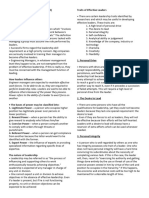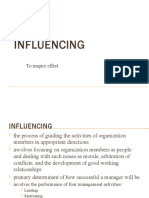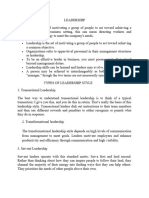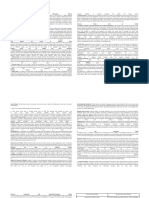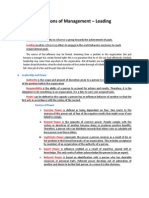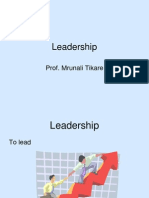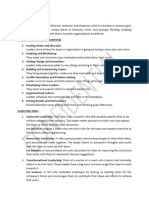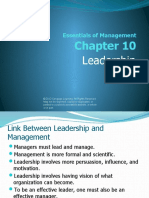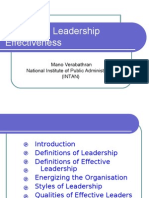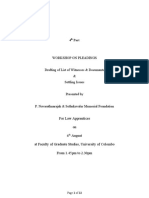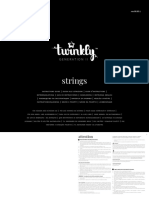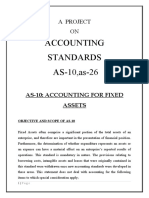Leadership Quick Reference Guide
from Group 2
Todays managers must know how to lead as well as manage in order to
have an effective organization.
Leadership The ability to inspire confidence and support among the people who are needed to achieve organizational goals.
Three representative
distinctions
Management is more formal and scientific than leadership.
Leadership involves having a vision of what the organization can become.
Managing focuses on continuous improvement of the status quo, whereas leadership is a force for change
that compels a group to innovate and depart from routine.
Links between
Management and
Leadership
1 Leadership vs. Management
The
Manager
The Tools of Management :
Power
Authority
Influence
Personal Traits
and Characteristics
Leadership
Behevior and
Practices
Improved
Productivity and
Morale
Power - The ability or potential to influence decisions and controlling
resources.
Authority - The formal right to get the people to do things or the formal
right to control resources.
Types of Power 1. Legitimate power is the authentic right of a leader to make a certain types of request.
2. Reward power is a leaders control over rewards of value to the group members.
3. Coercive power is a leaders control over punishments. Organizational punishments include assignment to
undesirable working hours, demotion and firing.
4. Expert power derives from a leaders job-related knowledge as perceived by group members
5. Referent power refers to the ability to control based on loyalty to the leader and the group members desire
to please that person.
6. Subordinate power is any type of power that employees can exert upward in an organization.
INFLUENCE TACTICS
1. Leading by example means that the leader influences group members by serving as a positive model of
desirable behavior.
2. Leading by values means the leader influences people by articulating and demonstrating values that guide
the behaviors of others.
3. Assertiveness refers to being forthright in your demands. It involves expressing what you want done and how
you feel about it.
4. Rationality means appealing to reason and logic. Strong leaders use this tactic frequently.
5. Ingratiation refers to getting somebody else to like you, often through the use of political skill.
6. Exchange is a method of influencing others by offering to reciprocate if they meet your demands.
7. Coalition formation is a way of gaining both power and influence. A coalition is a specific arrangement of
parties working together to combine their power, thus exerting influence on another individual or group.
8. Joking and kidding are widely used to influence others on the job. Good-natured ribbing is especially effective
when a straightforward statement might be interpreted as harsh criticism.
Empowerment Is a way for leaders to share a power, also referred to as shared leadership. When leaders share power,
employees experience a greater sense of personal effectiveness and job ownership.
2 Use of Power and Authority
THE EXERCISE OF POWER
SELF-LEADERSHIP AND EMPOWERMENT
For empowerment to work well, people must exercise self-leadership, the process of influencing
oneself. Self-leadership is possible because most people have the capacity to lead themselves,
particularly when faced with difficult yet important tasks.
CROSS-CULTURAL FACTORS AND EMPOWERMENT
Empowerment as a leadership technique works better in some cultures than in others. To the extent
that cultural values support the manager sharing power with group members, the more likely it is that
empowerment will lead to higher productivity and morale.
The typical pattern of behavior that a leader uses to influence his or her
employee to achieve organizational goal.
Participative Leader
A leader who shares decision making with group leaders.
Three Subtypes of
Participative leadership
Consultative Leaders- confer with subordinates before making a decision.
Consensus Leader- encourages group discussion about an issue and then makes a decision that
reflects general opinion (consensus) of group members.
Democratic Leaders- confer final authority on the group.
Autocratic Leader
A ask-oriented Leader who retain most of the authority for himself or herself and not generally
concerned with group members attitudes toward decision.
Leadership Grid
A visual representation of different combinations of a leaders degree of concern for task-related is
issues.
It is based on different integration of the leaders concern for production (results) and people
(relationships).
3 Leadership Style
Leadership Grid
(Managerial Grid)
The Seven Managerial Grid Style
This is based on how two fundamental concerns (for people and result) are
manifested at varying levels whenever people interact.
9, 1 Controlling (direct & dominate)
1, 9 Accommodating (yield & Comply)
5, 5 Status Quo (Balance & Comprehensive)
1, 1 Indifferent (Evade & Elude)
9, 9 Sound (Contribute and Commit)
PAT Paternalistic (prescribe and Guide
OPP Opportunistic (Exploit & Manipulate)
Interest in entrepreneurial leadership is intense because start-up
companies & other small enterprises are important source of new
employment.
Entrepreneurs often
possess the following
personal characteristics
and behaviors.
1. A strong achievement need. Entrepreneurs have stronger achievement needs than most managers.
Building a business is an excellent vehicle for accomplishment. The high achiever shows Three
Consistent behavior and attitudes.
He or she
(a) takes personal responsibility to solve problems,
(b) attempts to achieve moderate goals at moderate risks, &
(c) prefers situations that provide frequent feedback on results
2. High enthusiasm, creativity, and visionary perspective. Related to the achievement needed,
entrepreneurs are typically enthusiastic, creative, and visionary. As a result entrepreneurs are often
perceived as charismatic by their employees and customers. The enthusiasm of entrepreneurs propels them
into a hurrying mode much of the time
3. Uncomfortable with hierarchy and bureaucracy. Entrepreneurs by temperament, are not ideally suited to
working within the mainstream of a bureaucracy.
4 The Entrepreneurial
Leadership Style
Transformational Leader
-A leader who helps organizations and people who make
positive changes in the way they do things.
- It combines Charisma, inspirational leadership and intellectual
stimulation
Charismatic Leadership
-is important because it often leads to enhanced motivation &
satisfaction among subordinates.
Charisma : The ability to lead or influence others based on
personal charm, magnetism, inspiration and emotion.
3 ways on How
Transformational takes
place.
First, the transformational leader raises awareness of the importance and value of certain rewards
and how to achieve them.
Second, the transformational leader gets people to look beyond their self-interests for the sake of
the work group and the firm.
Third, the transformational leader helps people go beyond a focus on minor satisfactions to a guest
for self fulfillment
Charismatic Leadership
1. Vision
2. Masterful communication style
3.Elicits trust
4. Energy & Action orientation
5.Inspiring leader
Mentor
A more experienced person who develops a protege's abilities
through tutoring, coaching, guidance, and emotional support.
Shadowing
Directly observing the work activities of the mentor by following
the manager around for a period of time, such as one day per
month.
5 Transformational and
Charismatic Leadership
6 Leadership as a Mentor and
Coach
10 Behaviors and Actions that are relevant for a leader dealing with adversity
and crisis.
1. Make tough
decisions quickly
The best accepted principle of crisis leadership is that the leaders should take decisive action to remedy the
situation.
2. Serve as a model
by being resilient.
Effective managerial leaders are resilient
3. Present a plan for
dealing with the
adversity or crisis.
A key part of managing a crisis well is to present a plan for dealing with the crisis while at the same time
behaving in a calm and reassuring manner.
4. Appear confident
and trustworthy
Group members must trust that the leader or leaders can deal with the crisis.
5. Focus on the future
Part of being visionary is focusing on the future when the present is filled with difficulty.
6. Communicate
widely about the
problem.
When tough times hit, it pays to increase communication about the problems facing the company or discuss
what might be done to improve the situation.
7. Change to meet
changing
circumstances.
A bold leadership move is to change the thrust of a companys activities to adapt to changing circumstances
8. Stick with
constructive core
values
Leaders who keep their company or division focused on core values are likely to endure difficult times.
7 Leadership During
Adversity and Crisis
9. Divide major
problems into
smaller chunks.
Give workers bits of the major problem to work on so they feel less overwhelmed by the adversity facing
them and the company.
10. Lead with
compassion
Crises can take a heavy emotional toll on workers
The following checklist provides some additional skills that can
contribute to leadership effectiveness, depending on the people
and the task.
Additional Skills
Sizing up situations in order to apply the best leadership approach
Exerting influence through various approaches such as rational persuasion, inspirational appeal and
assertiveness.
Motivating team members through such specific techniques as goal setting & positive reinforcement.
Motivating people from diverse cultures and nations.
Resolving conflict with superiors and group members.
Solving problems creatively in ways that point group members in new directions.
Developing a mission statement that inspires others to perform well.
Leading a group through adversity.
8 Leadership Skills








